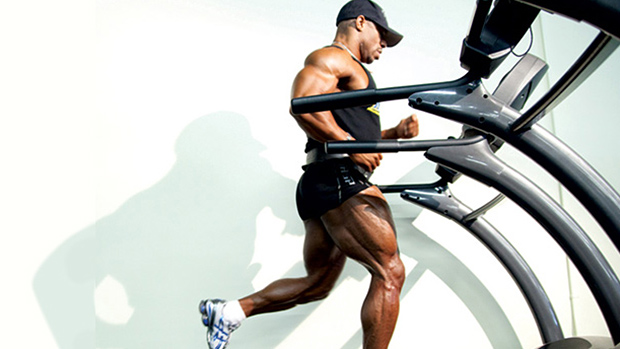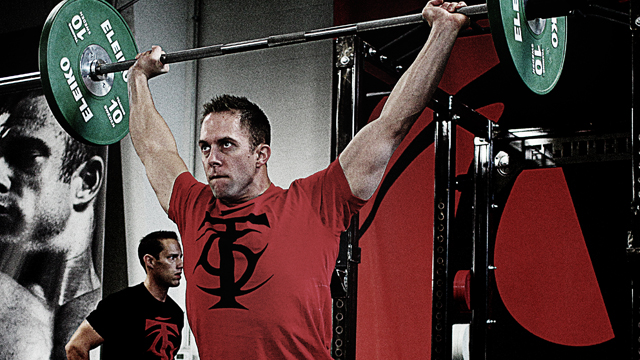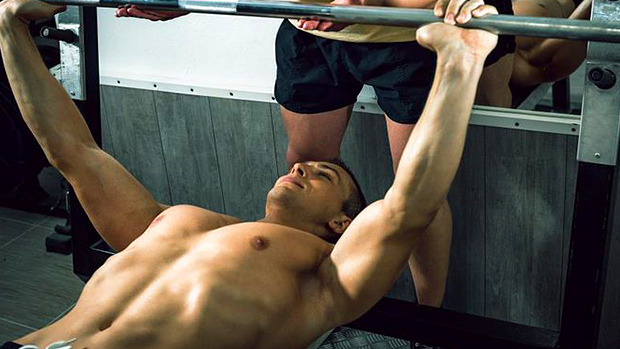When it comes to training purely for strength and power, it's become vogue to vehemently oppose "cardio." In light of the traditional connotation of "cardio" and "endurance training" – rubbing your ass raw on a bike for an hour – the individuals bashing such initiatives certainly have justification for their views.
However, "cardio" is a very general term. These individuals need to qualify their recommendations on a variety of fronts.
All practical applications are based on a foundation of scientific knowledge, so it's important that we briefly discuss energy systems and skeletal muscle fiber types. Let's start with the energy systems. You'll find four stops on the Energy System Tour. Please keep your arms and legs inside the bus at all times, and don't give change to the hobo in the backseat who's sitting in his own urine.
The continuum includes ATP-Creatine Phosphate, Anaerobic Glycolysis, Aerobic Glycolysis, and the Krebs Cycle. The former two are anaerobic and the latter two aerobic. As duration increases, there's increased contribution of aerobic energy systems. As intensity increases, the anaerobic energy systems are utilized more.
As you might imagine, resistance training (RT) is almost exclusively anaerobic, whereas very low-intensity endurance training (ET) and non-exercise scenarios (i.e. rest) rely on aerobic metabolism. Carbohydrates are the primary fuel source for the first two, whereas fat becomes increasingly important for aerobic mechanisms.
An important takeaway from this info is that the word "cardio" doesn't tell us much. We're training, not just working out, so it's important to determine ahead of time which energy systems we want to challenge with a particular exercise intervention. Fellow T-Nation contributor Christian Thibaudeau wisely conjured up the term "energy systems training" to encompass all of these activities. Within this classification, one can specify which energy system is being trained by a given activity. Gold star for Christian! Preach on, brother!
Skeletal muscle has specific contractile and morphological properties that are closely related to this metabolic continuum. We'll keep this relatively simple: Type I muscle fibers are slow-twitch (ST), Type IIb are fast-twitch (FT), and IIa are the middle-of-the-road fibers. This table illustrates the differences among the three fiber types (1):
| I | IIa | IIb/x | |
|---|---|---|---|
| Property | Oxidative | Oxidative-Glycolytic | Glycolytic |
| Fiber Color | Red | White | White |
| Motor Neuron Size | Small | Large | Largest |
| Z- and M-line Thickness | Thick | Thin | Thinnest |
| Sarcoplasmic Reticulum Development | Low | High | Highest |
| CaATPase isoform | Slow | Fast | Fastest |
| Force Output | Low | High | Highest |
| Contractile Speed | Slow | Fast | Fastest |
| Myosin Heavy Chain isoform predominance | Slow | Fast | Fastest |
| Time to Peak Tension | Slow | Fast | Fastest |
| Time to Relaxation | Slow | Fast | Fastest |
| Oxidative Capacity | High | Medium | Low |
| Myoglobin Content | Highest | High | Low |
| Glycolytic Capacity | Low | High | Highest |
| Succinate Dehydrogenase Activity | High | Medium | Low |
| Phosphofructokinase Activity | Low | Medium | High |
| Glycogen Content | Low | High | High |
| Capillary Density | High | High | Low |
| Mitochondrial Volume | High | Medium | Low |
Suffice it to say that ST fibers are better suited to low intensities, aerobic metabolism and endurance activities. FT fibers, on the other hand, are beneficial in terms of high intensities, anaerobic energy production and shorter duration events.
In terms of specific time periods, the ATP-CP system predominates in 0-10 second duration events, with 20 seconds as the upper limit. Anaerobic glycolysis is most active in the 15-30 second range; the aerobic/oxidative systems come into play almost exclusively once the work period is greater than one minute (and at rest). This assumes, however, that you're busting your butt to maintain the intensity.
Obviously, there's always going to be some overlap with the "changeover" from one energy system to another during an extended effort. According to the summation principle, if you're going to recruit FT fibers with a maximal effort, you need to recruit all the ST fibers first. No big deal. In fact, it's a good thing, as we want to be able to take advantage of as many motor units as possible for maximal efforts.
Conversely, the problem that's specific to this argument occurs when the available FT fibers are called upon to perform ST duties. In other words, intensity of endurance exercise gets too high, so these high-force, high-velocity fibers must become cardio bunnies – at least in the short term.
Over time, this scenario can lead to fiber shifts toward a more ST phenotype (more type I and IIa), characterized by upregulation of oxidative enzymes, increased myoglobin content, increased mitochondrial density, etc. Essentially, everything shifts to the left in the table I presented. These fiber shifts make strength and power athletes perform more like marathoners than the explosive, mighty beasts that they are.
It's well established that performing RT and endurance training ET concurrently attenuates the improvements observed when one modality is employed exclusively (2,3). In consideration of this attenuation, many athletes who must prioritize maximal strength and power (i.e. powerlifters, weightlifters, track and field throwers) have limited or altogether avoided ET in order to maximize the returns on their metabolic and neuromuscular-specific RT programs.
I can't say I blame them. This avoidance is completely understandable in light of what the scientific body of knowledge and anecdotal evidence has reported. But, in studies of concurrent RT and ET, researchers have typically utilized ET protocols geared toward improving VO2max (2,3). As such, the ET was in many cases performed at high enough intensities to require contribution of fast-twitch fibers to perform "slow-twitch duties."
Broadly speaking, the American College of Sports Medicine asserts that "those who are already physically active require exercise intensities at the high end of the intensity continuum to further augment their cardiorespiratory fitness. For most individuals, intensities within the range of 70-85% HRmax or 60-80% HRR (heart rate- reserve) are sufficient to achieve improvements in cardiorespiratory fitness, when combined with an appropriate frequency and duration of training" (4).
Conversely, "low-fit or deconditioned individuals (read: some strength and power athletes who do no supplemental work at all) may demonstrate increases in cardiorespiratory fitness with exercise intensities of only 40 to 49% HRR or 55-64% HRmax" (4). Kind of makes you wonder what would happen if the investigators for these RT + ET studies just backed off the intensity on the endurance training, huh?
Go figure, McCarthy et al. did just that. These researchers found that in a combined RT and ET protocol where ET was performed at only 70% HRR, untrained subjects in the combined training group experienced similar improvements in both peak VO2 and strength performance as the ET-only and RT-only groups, respectively (5).
Sure, these subjects were untrained, but so were the participants in some of the other studies that found decrements in strength with combined training protocols.
It's a legitimate question. As a lifter who's always looking to get stronger, I know I asked it at one time myself. Let's look at some potential benefits (according to both anecdotal and scientific evidence) of lower-intensity exercise, which I'll define as less than 70% heart rate reserve or 40% 1RM. Keep in mind that I don't include sprinters in this category of strength and power athletes, as sprinters fall more toward the power-endurance end of the spectrum. "Light-exercise" will mean something completely different for them. So, here are a few mechanisms by which light exercise may in fact facilitate RT progress:
- Indirect cardiac adaptations such as short-term increases in cardiac output and longer-term increases in capillary density of type I fibers (6). Collectively, these adaptations may promote blood flow to soft tissues and, in turn, nutrient delivery (7) and clearance of metabolic wastes (8). Obviously, the ability to generate and maintain body heat as a result of greater capillary density can also prove highly beneficial for strength and power athletes as well.
- Reduced delayed onset muscle soreness (DOMS) (8), possibly related in part to the aforementioned improvements in nutrient delivery and clearance of metabolic wastes. Ever wonder why baseball pitchers often go for long, slow jogs on the day or two after they throw? Strength and power work does little to improve circulation, so this work is welcomed relief from rigorous 120-pitch outings (or punching clubhouse walls, if your name is Kevin Brown).
- An opportunity to practice crucial movement patterns when the exercise chosen in competition-specific (e.g. light squats, benches or deadlifts for a powerlifter).
- Enhancement of psychological well-being (9).
- Improved insulin sensitivity (10), allowing for more efficient utilization of dietary carbohydrates in restoring glycogen and stimulation of protein synthesis.
- General physical preparedness (GPP), defined by Verkhoshansky as "conditioning exercises designed to enhance an athlete's general, non-specific work capacity" (10). As an athlete's work capacity increases, so too does his ability to adapt to increases in imposed volume demands.
Just as importantly, for athletes and non-athletes alike, endurance exercise offers numerous health benefits, including increased arterial compliance, decreased blood pressure, improved insulin sensitivity, improved glycemic control, and decreased body fat content (10, 12, 13, 14, 15, 16).
Sure, many of these benefits may be geared toward untrained, sedentary populations. However, given that many strength and power athletes seek absolute (rather than relative) strength and therefore may be "overweight" by general health standards, these health improvements would be highly beneficial for such athletes. In support of this notion, we learned in T-Nation's interview with Gary Homann that getting at least some aerobic exercise each week is related to an increased likelihood of being happy with one's weight (17). I know that correlation doesn't necessarily equate to causation, but if you don't feel fat, I'm guessing that you're less likely to actually be fat.
Just to tie things together, it's quite well established that traditional ET interferes with gains in maximal strength and power – through fast to slow twitch muscle fiber shifts (18,19) – and, as such, is often avoided by the strength and power athletes. It follows that individuals who employ RT as their sole exercise modality may actually be at greater risk of chronic, preventable disease (19), possibly due in part to the exclusion of ET. I'm not trying to scare you, I swear!
I'm pretty sure that all of you really big guys out there are already composing nasty emails to me about how much you hate cardio, so I'll get to the point. This isn't something to be dreaded, as you a) have a lot of room for variety and b) should intentionally avoid working hard. Call it managed fatigue or structured slacking, if it makes you feel any better.
You see, every one of you does "aerobic activity." Hell, reading this article is aerobic. We need to can the stereotypes, talk a little science, and in the end quit bastardizing the word "aerobic." Instead, it's time to start qualifying the energy system work one does as appropriate or inappropriate.
What's the first thing you did when you got out of bed this morning? You walked to the bathroom to relieve yourself. Then, you walked to the kitchen to make yourself breakfast. Then, you walked to the shower to get clean. Then, you walked to your bedroom closet to get dressed. If you're not noticing a pattern here, then perhaps you'd be better off with a coloring book than a T-Nation article...
You walk all day long. Walking – just like the vast majority of things you do in your everyday life – is almost completely aerobic in nature. Traditionally, cardiovascular training has been synonymous with aerobic training, the end goal being optimization of endurance performance. Now, this is all well and good if you're an endurance athlete, but what are the implications for strength and power athletes?
Simply stated, low-intensity aerobic work can be completely handled by the slow-twitch motor units (neuron and the fibers it innervates). It's fair to assume that strength and power athletes who aren't endurance trained are still probably in better shape than the untrained subjects in McCarthy's study, so the 70% heart rate reserve threshold carries over without much problem.
Likewise, 40% of 1RM isn't all the challenging. You ought to be able to pump out 40 or 50-rep sets with this weight. Just to be safe, though, I recommend sticking in the 60% heart rate reserve and 30% 1RM range for the low-intensity interventions I'll suggest.
The timing of these sessions is just as important as intensity. I encourage you to not perform them after lifting unless your lifting takes you less than 40 minutes, and you're only planning on doing a brief (ten minute) low-intensity session. We're not looking to perform marathon sessions or call upon the FT fibers to "get their aerobics on" once the ST fibers are more fatigued. Rather, they should be used on non-lifting days or several hours separated from a lifting session.
With the latter set-up, an ideal scenario would be to lift earlier in the day and do this blood flow work roughly six hours later. By the way, don't do this stuff first thing in the morning on an empty stomach. That silly practice has been beaten to death by bodybuilders already. I prefer that we not encounter such a hopeless intervention in strength and power athletes, too.
Here are some options. Feel free to combine a few of them in the same session to keep things interesting:
- Traditional steady-state "cardio": Walking with or without incline (preferably outdoors) is good for those with very low tolerance to aerobic exercise. Others may be able to handle light jogging. Be cognizant of orthopedic stress, though; some people are just too heavy for impact exercise. Swimming, treading water and underwater jogging are great alternatives as well.
- Elliptical machines: Thy can be used too, although I'd rather not see athletes on cardio machines (especially cycles) at all because of the restricted range of motion and potential for pattern overload. Then again, they're better than nothing. Getting it done is more important than how you do it, as we're looking for a systemic – not just muscular – effect. As I mentioned above, keep your intensity at roughly 60% of your age-predicted maximum heart rate ([220-age] x .6). Twenty minutes is plenty.
- Strongman implements: Assuming the implements are kept somewhat lighter than normal, these choices are excellent recovery tools (as opposed to heavier use, which characterizes more sport-specific energy system training for various athletes). Wheelbarrow walks and farmer's walks are great choices, and you can always flip "smaller oversize" tires. Sled dragging takes the cake, though. There are a ton of different variations you can do to enhance your work capacity.
- Dynamic Flexibility Circuits: This one is a favorite of mine, as you're actually improving your range of motion while improving your work capacity. Simply take body weight exercises like overhead lunge walks, lateral squats, knee-to-chests, scorpions, butt-kicks, etc., and work on getting your heart rate up a bit. Go in bouts of 30 seconds at a brisk, but deliberate pace.
- High-Rep Band Work: This follows the same general template as #4, but bands can be a great change of pace and especially valuable because you can take them anywhere. Be creative, from good mornings with the band under your feet and looped over your neck, to band woodchops, to pull-aparts, to pull-throughs, the sky's the limit!
- Low-intensity Resistance Exercise: Pick 8-12 exercises, approximate 30% of your estimated 1RM for these exercises, and cycle through them. Do 20 reps per set and keep your rest time as short as possible between sets. With each week, add a little volume until your work capacity has improved to an admirable level.
Generally, I'll choose one from each of the following categories: hip dominant movement, single-leg movement (typically quad dominant), horizontal push, horizontal pull, hip abduction, trunk flexion, trunk rotation or lateral flexion, elbow extension, elbow flexion, and humeral external rotation.
These selections are by no means set in stone; for instance, I may include vertical pushing and pulling exercises, depending on one's weaknesses and work capacity. These sessions are fantastic times to emphasize prehabilitation and neural activation work to get often-dormant muscles (e.g. all three glutes, serratus anterior, VMO) into their grooves.
Below you'll find a few sample circuits to get you on the right track. I encourage you to simply use them as templates from which to design your own individualized circuits. I try to alternate among upper body, lower body, and core exercises to allow for more complete recovery. Pick a circuit and repeat it 2-3 times.
Circuit A
- Reverse Hypers
- Dumbbell Bench Presses
- Mini-band Sidesteps
- Seated Cable Rows
- Pulldown Abs
- Pressdowns
- Walking Dumbbell Lunges
- Dumbbell Hammer Curls
- Side Hip Thrusts
- Dumbbell Cuban Presses
Circuit B
- Face Pulls
- Pull-throughs
- Push-ups
- Dumbbell Step-ups
- Low-Pulley External Rotation
- Stability Ball Crunches
- Supinated Grip Pulldowns (substituted for elbow flexion)
- Body weight box squats with mini-bands around knees (abduction emphasis)
- Cable Woodchops
- Lying Dumbbell Extension
You might note the remarkable similarity of these recommendations to the GPP advocated by many Westside-influenced powerlifters. It makes sense, as these individuals are strength and power athletes. If you peruse the training logs of Elite lifters, you'll even find that several of them regularly incorporate traditional "cardio" at low intensities. Paul Childress, a man who's already squatted over 1,100 pounds, immediately comes to mind.
Professional strongman Brad Cardoza utilizes similar protocols as well. According to Brad, "I personally love these workouts, I'll go to the gym on a day off and do four to six supersets (2 x 25 on each exercise). It's just enough weight to get a pump, but not enough to actually fatigue the muscle. It took me a while to get used to doing these extra workouts, but now I hit them at least once a week and usually feel great the next day."
Likewise, Jesse Burdick, who'll be squattin' a grand in no time, notes the following:
"After gaining close to 80 pounds in a year due to training on a traditional Westside protocol and eating everything in sight, my numbers went crazy, but my conditioning went the way of the toilet. After trying to just add in some GPP pre-workout and that not working, I knew it was time to try something else.
"Paul Childress told me about his walking, but I wasn't convinced because it was cardio and he was a powerlifter. Cressey reiterated what Paul had said and offered the scientific rationale for it. I wasn't necessarily just interested in losing weight; I just wanted to feel better, get stronger, be healthy, and be able to walk up stairs without the need for a burrito break. He recommended the walking and the 'light' circuit to me. I haven't died yet, or started to wear leg warmers, but I have been feeling better. My back is a little looser and it's easier for me to stretch.
"On Wednesday and Friday, I walk at a 5% grade at a speed of 3.0 for 15 minutes, keeping my heart rate no higher than 115. I then head over to the weight area and pick the first eight exercises that I think of to address my weaknesses and do two sets of them at a high-rep, low-weight protocol. It works for me."
Any takers for arguing with any of these giants about the value of supplemental low-intensity work? I didn't think so.
If these individuals didn't think that these interventions were helping to make them stronger and healthier, would they be doing them? I've used this strategy myself over the past year with great success, too, so don't think that I'm just theorizing about all this.
Many people will be quick to jump all over me about the unfavorable endocrine response associated with ET. Since I'm such a nice guy, I'll do them the courtesy of making their argument for them. My counterarguments follow:
Point:
"Basal serum total Testosterone and free Testosterone concentrations were lower in elite amateur cyclists than in age-matched weightlifters or untrained individuals" (20). This data is consistent with previous research regarding endurance training and basal Testosterone concentrations (22,23).
Counterpoint:
Elite cyclists utilize much longer durations and higher intensities than I'm recommending. This drop in reading T concentrations could also be psychological; after all, they do wear goofy suits (although this goofiness is closely rivaled by those baggy bodybuilder pants).
Interestingly, in a study comparing acute hormonal responses of resistance-exercise and endurance exercise at only 50-55% VO2max, Tremblay et al found that "the endogenous hormone profile of men is more dependent on exercise mode or intensity than exercise volume as measured by caloric expenditure. The relatively catabolic environment observed during the resistance session may indicate an intensity rather than a mode-dependent response" (24).
Yes, folks, cortisol was higher and Testosterone was lower in the RT group. Why? It's because the endurance exercise wasn't all that intense; 50% VO2max is actually a warm-up in many moderate-intensity endurance training protocols (25)! The body had no need to get catabolic or (presumably) call upon a ton of FT fibers.
Think of this ET intensity as being closer to walking around the house than completing a triathlon. Unless you need a forklift to "briskly move" from Point A to Point B, this "vigorous" activity shouldn't push you into a muscle-wasting, catabolic coma. Then again, if you're in the forklift crowd, you have bigger concerns (pun intended).
Sprinter-like low-intensity work may actually have deleterious effects on a powerlifter's performance. Likewise, most sprinters probably couldn't handle a powerlifter's GPP. Toss endurance athletes in there and you've got an overworked, maladapted athlete casserole.
In other words, you really have to match the supplemental low-intensity work to the athlete. Integrate it gradually, doing it only once per week initially. Over time, you should be able to work up to three sessions per week (or possibly more, if shorter in duration).
Once you've attained your desired level of conditioning, don't worry anymore about increasing the frequency or duration of sessions; this conditioning is more easily maintained than it is built in the first place.
Oh, and please keep the hate mail to a minimum. This "cardio" ain't that bad!
- VanHeest, J. Unpublished. 2004.
- Kraemer WJ, et al. Compatibility of high-intensity strength and endurance training on hormonal and skeletal muscle adaptations. J Appl. Physiol. 1995;78:976-89.
- Bell GJ, et al. Effect of concurrent strength and endurance training on skeletal muscle properties and hormone concentrations in humans. Eur.J Appl. Physiol. 2000;81:418-27.
- American College of Sports Medicine. ACSM's guidelines for exercise testing and prescription: 6th edition. Lippincott, Williams, and Wilkins, 2000.
- McCarthy JP, et al. Compatibility of adaptive responses with combining strength and endurance training. Med.Sci.Sports Exerc. 1995;27:429-36.
- Shono N, et al. Effects of low intensity aerobic training on skeletal muscle capillary and blood lipoprotein profiles. J Atheroscler. Thromb. 2002;9:78-85.
- Eriksson K.F., et al. Increased skeletal muscle capillary density precedes diabetes development in men with impaired glucose tolerance. A 15-year follow-up. Diabetes. 1994;43:805-808.
- Tesch, P. A. and J. E. Wright. Recovery from short term intense exercise: its relation to capillary supply and blood lactate concentration. Eur. J. Appl. Physiol. Occup. Physiol. 1983;52:98-103.
- Sayers SP, et al. Activity and immobilization after eccentric exercise: I. Recovery of muscle function. Med. Sci. Sports Exerc. 2000;32:1587-92.
- Jennen C, et al. Exercise and Life-Satisfactory-Fitness: Complementary Strategies in the Prevention and Rehabilitation of Illnesses. Evid. Based. Complement Alternat. Med. 2004;1:157-65.
- Nishida Y, et al. Effect of mild exercise training on glucose effectiveness in healthy men. Diabetes Care 2001;24:1008-13.
- Verkhoshansky, YV. Programming and Organization of Training. Sportivny Press, 1988.
- Kingwell BA. Large artery stiffness: implications for exercise capacity and cardiovascular risk. Clin Exp. Pharmacol. Physiol. 2002;29:214-7.
- Pescatello LS, et al. American College of Sports Medicine position stand. Exercise and hypertension. Med. Sci. Sports Exerc. 2004;36:533-53.
- Peters AL. The clinical implications of insulin resistance. American Journal of Managed Care. 2000;6:S668-S674.
- Albright A, et al. Exercise and type 2 diabetes. Medicine and Science in Sports and Exercise. 2000;32:1345-60.
- Jakicic JM, et al. American College of Sports Medicine position stand. Appropriate intervention strategies for weight loss and prevention of weight regain for adults. Med. Sci. Sports Exerc. 2001;33:2145-56.
- Berardi, JM. Long haul training: An interview with Gary Homann. Testosterone Magazine 23 Dec 2004.
- Putman CT, et al. Effects of strength, endurance and combined training on myosin heavy chain content and fibre-type distribution in humans. European Journal of Applied Physiology. 2004;92:376-84.
- Thayer R, et al. A decade of aerobic endurance training: histological evidence for fibre type transformation. J Sports Med. Phys. Fitness. 2000;40:284-9.
- Miyachi M, et al. Unfavorable effects of resistance training on central arterial compliance: a randomized intervention study. Circulation. 2004;110:2858-63.
- Izquierdo M, et al. Maximal strength and power, muscle mass, endurance and serum hormones in weightlifters and road cyclists. J Sports Sci. 2004 May;22(5):465-78.
- Maimoun L, et al. Testosterone is significantly reduced in endurance athletes without impact on bone mineral density. Horm Res. 2003;59(6):285-92.
- Hackney AC, et al. Basal testicular testosterone production in endurance-trained men is suppressed. Eur J Appl Physiol. 2003 Apr;89(2):198-201. Epub 2003 Feb 28.
- Tremblay MS, et al. Effect of training status and exercise mode on endogenous steroid hormones in men. J Appl Physiol. 2004 Feb;96(2):531-9. Epub 2003 Sep 26.
- Ronsen O, et al. Increased neuroendocrine response to a repeated bout of endurance exercise. Med Sci Sports Exerc. 2001 Apr;33(4):568-75.





